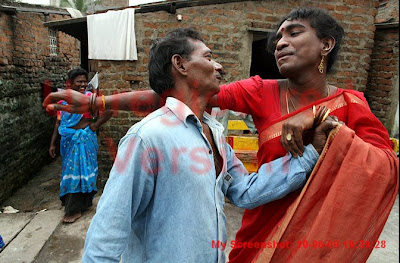WIFE AND DAUGHTERS TO PAY THE LOAN IN BUNDELKHAND
From Pankaj Jaiswal, Hindustan Times
Email Author
Jhansi/Chitrakoot, October 05, 2009
First Published: 00:00 IST(5/10/2009)
Last Updated: 01:35 IST(5/10/2009)
There are no bad debts in Bundelkhand.
If a man cannot repay a loan in cash, a wife or daughter will often do just as well.
As authorities in Uttar Pradesh and Madhya Pradesh seemingly look the other way, women in drought-prone, impoverished Bundelkhand, a cluster of 13 forgotten districts that lies along the borders of the two states are paying the price for bad loans with their liberty.
“Make me happy and the debt will be waived, he would say to me,” says Anita (name changed), her teeth gritted in rage.
She was 17 when a powerful moneylender in Sipri Bazaar, Jhansi, first came to her parents’ home and declared that he would take in kind what they had been unable to repay in cash.
Anita’s illiterate father had taken a loan of Rs 5,000, but signed a deed that said the sum was Rs 50,000.
A labourer with no assets, he had no hope of repaying the loan. He had to let his daughter be led away by the moneylender.
For the next six months, the moneylender allegedly returned repeatedly, taking Anita away and sending her home a few hours later.
Finally, in April 2007, Anita walked from his house to the local police station and filed a case of rape and aggravated assault.
“He got bail in a few hours,” she says, the rage returning to her face.
The practice of women being used as collateral shot into the news early last month, when another man from Jhansi who had allegedly lost his wife to a moneylender began a fight to get her back.
The moneylender had allegedly passed Kalicharan’s wife Kusma Devi on to an acquaintance, Deshraj, in a nearby village.
When he was questioned, Deshraj showed district officials a Rs 10 stamp paper that said he and the woman were married.
The case caught the attention of the National Commission for Women (NCW), which sent in a team to investigate. The UP Congress unit also set up a team to look into the matter.
Though Yasmeen Abrar, the head of the four-member NCW team, declined to comment in detail before she submitted her report to the Union government, she told reporters: “It is a matter of investigation how this woman came to live with another man. We think this is not an isolated case. We intend to dig deeper into this issue in the region.”
Abrar said she also planned to look into what action the administration was taking in the matter.
“This is neo-feudalism,” says Bhagwat Prasad, director of a local non-profit that fought against this practice in the local tribal community in the early 1990s.
“The wealthy have all the power and women are considered an extension of a man’s property and assets.”
There is no record of how many women are suffering in this way, Prasad adds.
“With suicides, there is a dead body, so everyone has to sit up. Here, the women are faceless and voiceless, invisible victims of an invisible crime.”
As far as the administration is concerned, however, there is no neo-feudalism.
“There is no such thing going on,” said Uttar Pradesh Principal Secretary (Women and Child Welfare) Amal Verma. “If you know of any cases, why don’t you send them to us and we’ll investigate.”
Meanwhile, about 115 kilometers from Anita’s one-room mud hut, victims turned culprits as an enraged couple in Barora village hit back at another powerful moneylender in 2006.
When Mahesh Chandra offered to waive a Rs 2,500 loan and throw in an additional Rs 500 in exchange for Bhagwati Devi (30), her husband Chandrabhan (34) lunged at the man with just the towel he held in his hands.
The police report says the couple ended up strangling Mahesh Chandra, and were arrested for murder. Bhagwati, a mother of four, spent the next two years in jail. Chandrabhan is still in prison.
Now, Bhagwati supports her family by selling trinkets and cosmetics to village girls. “I’m lucky if I can afford a few bananas for the children every day,” she says.
“And I don’t know how long I can afford to keep them all in school.”








